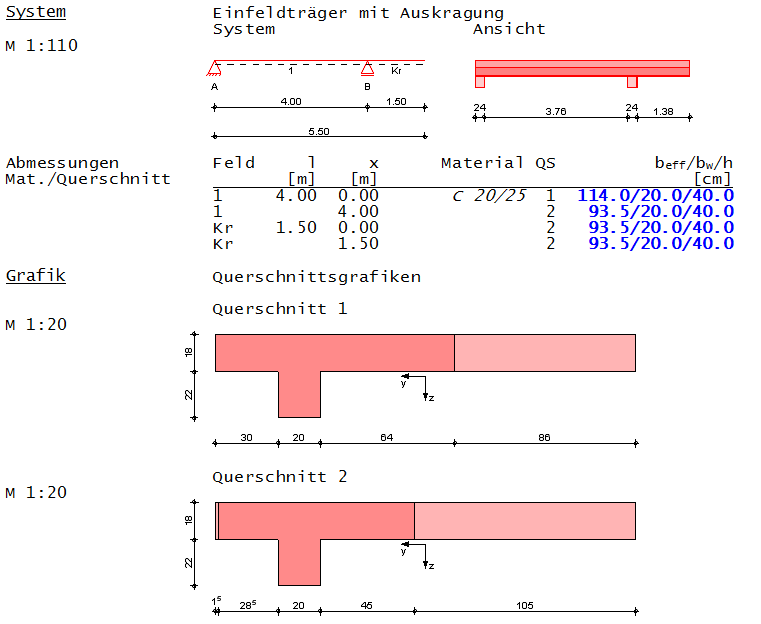Mitwirkende Plattenbreite (Bsp.): Unterschied zwischen den Versionen
Zur Navigation springen
Zur Suche springen
| (19 dazwischenliegende Versionen von 3 Benutzern werden nicht angezeigt) | |||
| Zeile 1: | Zeile 1: | ||
| + | |||
| + | <br /> | ||
| + | |||
==Beispiel 1 <small>Stahlbeton-Plattenbalken mit Kragarm</small>== | ==Beispiel 1 <small>Stahlbeton-Plattenbalken mit Kragarm</small>== | ||
| + | Das folgende Beispiel zeigt eine Berechnung der [[Zusatzangaben Plattenbalken (S340.de)#Berechnungsgrundlagen für die Ermittlung der mitwirkenden Plattenbreite|mitwirkenden Plattenbreite]], wie Sie mit dem Modul S340.de geführt wird. | ||
=== Aufgabe === | === Aufgabe === | ||
Ermittlung der mitwirkenden Plattenbreite eines Plattenbalkens am Randbereich:<br /> | Ermittlung der mitwirkenden Plattenbreite eines Plattenbalkens am Randbereich:<br /> | ||
| Zeile 14: | Zeile 18: | ||
<br /> | <br /> | ||
==== Vorgabewerte ==== | ==== Vorgabewerte ==== | ||
| − | Die Ermittlung der [[Effektive Stützweiten ( | + | Die Ermittlung der [[Effektive Stützweiten (S***.de)|effektiven Stützweiten]] erfolgte nach Regeln des Moduls S340.de<br /> |
<br /> | <br /> | ||
| − | <math>l_\mathrm{eff,1}=400\,\mathrm{cm}</math><br /> | + | <math>l_\mathrm{eff,1}=400\,\mathrm{cm}</math><br /><br /> |
<math>l_\mathrm{eff,Kr}=150\,\mathrm{cm}</math><br /> | <math>l_\mathrm{eff,Kr}=150\,\mathrm{cm}</math><br /> | ||
| Zeile 22: | Zeile 26: | ||
==== wirksame Stützweiten ==== | ==== wirksame Stützweiten ==== | ||
<br /> | <br /> | ||
| − | <math>l_\mathrm{0,1}=0{,}85 \cdot l_\mathrm{eff,1}=0{,}85 \cdot 400\,\mathrm{cm} = \underline{340\,\mathrm{cm}} </math><br /> | + | <math>l_\mathrm{0,1}=0{,}85 \cdot l_\mathrm{eff,1}=0{,}85 \cdot 400\,\mathrm{cm} = \underline{340\,\mathrm{cm}} </math><br /><br /> |
<math>l_\mathrm{0,Kr}=1{,}5 \cdot l_\mathrm{eff,Kr}=1{,}5 \cdot 150\,\mathrm{cm} = \underline{225\,\mathrm{cm}} </math><br /> | <math>l_\mathrm{0,Kr}=1{,}5 \cdot l_\mathrm{eff,Kr}=1{,}5 \cdot 150\,\mathrm{cm} = \underline{225\,\mathrm{cm}} </math><br /> | ||
==== Feld 1 ==== | ==== Feld 1 ==== | ||
| − | |||
<br /> | <br /> | ||
| − | <math>b_{w} | + | <math>b_\mathrm{eff}=b_\mathrm{eff,1} + b_\mathrm{eff,2} + b_\mathrm{w}~</math><br /> |
| − | <math>b_{eff,1}=min\begin{cases} | + | <br /> |
| − | 0,2 | + | <math>b_\mathrm{w}=20\,\mathrm{cm}</math><br /> |
| − | 0,2 | + | <br /> |
| − | b_{1} &= | + | <math>b_\mathrm{eff,1}=\mathrm{min}\begin{cases} |
| + | 0{,}2 \cdot 30\,\mathrm{cm} + 0{,}1 \cdot 340\,\mathrm{cm} &= 40\,\mathrm{cm} \\ | ||
| + | 0{,}2 \cdot 340\,\mathrm{cm} &= 68\,\mathrm{cm} \\ | ||
| + | b_\mathrm{1} &= \underline{30\,\mathrm{cm}} | ||
\end{cases}</math><br /> | \end{cases}</math><br /> | ||
<br /> | <br /> | ||
| − | <math>b_{eff,2}=min\begin{cases} | + | <math>b_\mathrm{eff,2}=\mathrm{min}\begin{cases} |
| − | 0,2 | + | 0{,}2 \cdot 150\,\mathrm{cm} + 0{,}1 \cdot 340\,\mathrm{cm} &= \underline{64\,\mathrm{cm}} \\ |
| − | 0,2 | + | 0{,}2 \cdot 340\,\mathrm{cm} &= 68\,\mathrm{cm} \\ |
| − | b_{2} &= | + | b_\mathrm{2} &= 150\,\mathrm{cm} |
\end{cases}</math><br /> | \end{cases}</math><br /> | ||
<br /> | <br /> | ||
| − | <math>b_{eff}=30 cm +64 cm +20 cm= | + | <math>b_\mathrm{eff}=30\,\mathrm{cm} + 64\,\mathrm{cm} + 20\,\mathrm{cm}= \underline{\underline{114\,\mathrm{cm}}}</math><br /> |
==== Kragarm ==== | ==== Kragarm ==== | ||
| − | |||
<br /> | <br /> | ||
| − | <math>b_{w} | + | <math>b_\mathrm{eff}=b_\mathrm{eff,1} + b_\mathrm{eff,2} + b_\mathrm{w}~</math><br /> |
| − | <math>b_{eff, | + | <br /> |
| − | 0,2 | + | <math>b_\mathrm{w}=20\,\mathrm{cm}</math><br /> |
| − | 0,2 | + | <br /> |
| − | b_{1} &= 30 cm | + | <math>b_\mathrm{eff,1}=\mathrm{min}\begin{cases} |
| + | 0{,}2 \cdot 30\,\mathrm{cm} + 0{,}1 \cdot 225\,\mathrm{cm} &= \underline{28{,}5\,\mathrm{cm}} \\ | ||
| + | 0{,}2 \cdot 225\,\mathrm{cm} &= 45\,\mathrm{cm} \\ | ||
| + | b_\mathrm{1} &= 30\,\mathrm{cm} | ||
\end{cases}</math><br /> | \end{cases}</math><br /> | ||
<br /> | <br /> | ||
| − | <math>b_{eff, | + | <math>b_\mathrm{eff,2}=\mathrm{min}\begin{cases} |
| − | 0,2 | + | 0{,}2 \cdot 150\,\mathrm{cm} + 0{,}1 \cdot 225\,\mathrm{cm} &= 52{,}5\,\mathrm{cm} \\ |
| − | 0,2 | + | 0{,}2 \cdot 225\,\mathrm{cm} &= \underline{45\,\mathrm{cm}} \\ |
| − | b_{2} &= | + | b_\mathrm{2} &= 150\,\mathrm{cm} |
\end{cases}</math><br /> | \end{cases}</math><br /> | ||
<br /> | <br /> | ||
| − | <math>b_{eff}=28,5 cm +45 cm +20 cm= | + | <math>b_\mathrm{eff}=28{,}5\,\mathrm{cm} + 45\,\mathrm{cm} + 20\,\mathrm{cm}= \underline{\underline{93{,}5\,\mathrm{cm}}}</math><br /> |
=== Vergleich mit mb-AEC Baustatik === | === Vergleich mit mb-AEC Baustatik === | ||
| − | Bei Ermittlung der mitwirkenden Plattenbreite | + | Bei Ermittlung der mitwirkenden Plattenbreite erscheint folgender Ausdruck:<br /> |
<br /> | <br /> | ||
| Zeile 70: | Zeile 78: | ||
| − | == | + | {{Seiteninfo(mb) |
| − | + | |Quality-flag = [[File:quality-flag-orange.gif|right|70px]] | |
| − | + | |Status = Seite fertig, ungeprüft| | |
| − | + | |Modul-Version = 2014.011 | |
| − | + | }} | |
| − | [[Kategorie:Beispiele]] | + | [[Kategorie:Beispiele-Stahlbetonbau]] |
Aktuelle Version vom 11. November 2019, 17:14 Uhr
Beispiel 1 Stahlbeton-Plattenbalken mit Kragarm
Das folgende Beispiel zeigt eine Berechnung der mitwirkenden Plattenbreite, wie Sie mit dem Modul S340.de geführt wird.
Aufgabe
Ermittlung der mitwirkenden Plattenbreite eines Plattenbalkens am Randbereich:
Ansicht
Schnitt A-A
Vorgabewerte
Die Ermittlung der effektiven Stützweiten erfolgte nach Regeln des Moduls S340.de
Berechnung
wirksame Stützweiten
Feld 1
Kragarm
Vergleich mit mb-AEC Baustatik
Bei Ermittlung der mitwirkenden Plattenbreite erscheint folgender Ausdruck:
Quellen
Seiteninfo
|















